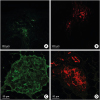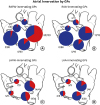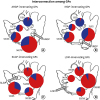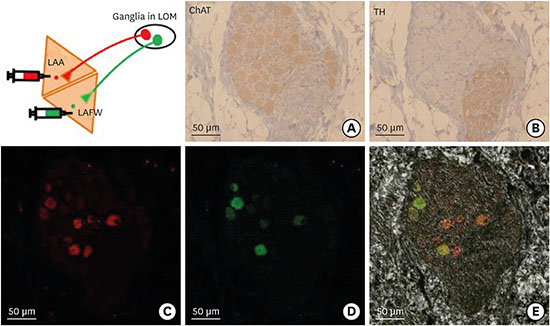INTRODUCTION
METHODS
Animal preparation
Retrograde neuronal tracer
 | Fig. 1The mechanism of CTB-AF as a retrograde neuronal tracer and anatomic locations of injection sites. (A) When the fluorescence conjugated CTB was injected into a particular muscle, CTB retrogradely transferred along nerve axons and identified the origin of innervating neuronal cells in ganglia. (B) The location of injection sites of Experiment 1. (C) The location of injection sites of Experiment 2.CTB-AF = cholera toxin subunit B conjugated with Alexa Fluor, LAA = left atrial appendage, LAFW = left atrial free wall, LOM = ligament of Marshall, SLGP = superior left ganglionated plexi, SVC-Ao FP = superior vena cava-aorta fat pad, RAA = right atrial appendage, RAFW = right atrial free wall, ARGP = anterior right ganglionated plexi, IRGP = inferior right ganglionated plexi.
*CTB-AF injection sites.
|
Injection of CTB-AF
Table 1
Summary of the injection sites, the type of injected CTB-AF, and results of quantitative analysis in each experimental animal

Experiment 1: atrial innervation by GPs
Experiment 2: neuroanatomical interconnections among GPs
Histologic evaluation
Data analysis
Ethics statement
RESULTS
 | Fig. 2CTB-AF injection sites observed via a confocal microscope. (A) Intense green-fluorescence is observed in the LAA injection site (× 100). (B) Highly focused red-fluorescence is observed in the LAFW injection site (× 100). Scale bar, 100 µm. (C) A representative ganglia located in the ARGP injected with CTB-AF 488 (× 200). Intense green-fluorescence is distributed within the cell bodies of neuronal cells and transversely sectioned axon bundles. (D) Ganglia located in the IRGP injected with CTB-AF 555 shows intense red-fluorescence in neuronal cell bodies and axons (× 200). Scale bar, 50 µm.CTB-AF = cholera toxin subunit B conjugated with Alexa Fluor, LAA = left atrial appendage, LAFW = left atrial free wall, ARGP = anterior right ganglionated plexi, IRGP = inferior right ganglionated plexi.
|
 | Fig. 3The mean number of total ganglia in each ganglionated plexi.GP = ganglionated plexi, SVC-Ao FP = superior vena cava-aorta fat pad, ARGP = anterior right ganglionated plexi, IRGP = inferior right ganglionated plexi, SLGP = superior left ganglionated plexi, LOM = ligament of Marshall.
|
GP patterns of atrial innervation (Experiment 1)
 | Fig. 4Comparison of immunohistochemical staining and CTB-labeled cells in the ganglia of LOM by confocal microscope. (A) ChAT staining showing the parasympathetic nature of most neuronal cells in a ganglia. (B) TH staining showing the sympathetic axon bundles within the same ganglia. (C) CTB with red-fluorescence labeled neuronal cells in a ganglia. (D) CTB with green-fluorescence labeled neuronal cells in a ganglia. (E) Merged image of two types of fluorescence (all, × 200). Scale bar, 50 µm. In this animal, each green and red fluorescent spot indicates neurons innervating the LAA and LAFW, respectively. Note that some neuronal cells are labeled with two fluorescent colors (green and red) within the same cell body.CTB-AF = cholera toxin subunit B conjugated with Alexa Fluor, LOM = ligament of Marshall, ChAT = choline acetyltransferase, TH = tyrosine hydroxylase, LAA = left atrial appendage, LAFW = left atrial free wall.
|
 | Fig. 5Semi-quantitative analysis of a CTB-labeled ganglia in each GP by CTB-AF injected atrial area (Experiment 1). Semi-quantitative analysis was performed using the pooled number of all experimental animals labeled at each atrial site. Asterisks indicate CTB-AF injection sites. Pie charts show the location of each GP and the proportion of CTB-labeled ganglia. The darker gray colored section of the pie chart indicates the proportion of CTB-labeled ganglia. Numbers next to the pie charts indicate the value obtained for the ratio: CTB-labeled ganglia/total ganglia in each GP. (A) RAFW injection (n = 4), (B) RAA injection (n = 3), (C) LAFW injection (n = 2), (D) LAA injection (n = 2).CTB-AF = cholera toxin subunit B conjugated with Alexa Fluor, GP = ganglionated plexi, RAFW = right atrial free wall, RAA = right atrial appendage, LAFW = left atrial free wall, LAA = left atrial appendage.
*Atrial injection site.
|
Neuroanatomical interconnections among GPs (Experiment 2)
 | Fig. 6Semi-quantitative analysis of the distribution of CTB-labeled ganglia by CTB-AF injected GP (Experiment 2). The numbers of CTB-labeled ganglia and total ganglia were pooled according to injection site. In the pie charts, the proportion of CTB-labeled ganglia is presented as a darker gray colored segment. Numbers indicate the value obtained for the ratio: labeled ganglia/total ganglia. Retrograde tracers which were injected into a particular GP became widely distributed into 4 other GPs. (A) ARGP injection (n = 2), (B) IRGP injection (n = 2), (C) SLGP injection (n = 2), (D) LOM injection (n = 2).CTB-AF = cholera toxin subunit B conjugated Alexa Fluor, ARGP = anterior right ganglionated plexi, IRGP = inferior right GP, SLGP = superior left GP, LOM = ligament of Marshall.
|
 | Fig. 7Representative confocal images of neuronal cells labeled by fluorescence from different GPs (Experiment 2). (A) This ganglia is located in the ARGP and was directly injected with green-fluorescence conjugated CTB. In some green-fluorescence labeled cells, red-fluorescence labeled cells are also observed. Red-fluorescence was injected into the IRGP. (B) The ganglia in the SVC-Ao FP shows green and red fluorescent neuronal cells, and also dually labeled cells. This GP was not directly injected with any type of CTB-AF. In this animal, green-fluorescence was injected into the SLGP and red-fluorescence was injected into the LOM (all, × 200). Scale bar, 50 µm.GP = ganglionated plexi, ARGP = anterior right ganglionated plexi, CTB = cholera toxin subunit B, IRGP = inferior right ganglionated plexi, SVC-Ao FP = superior vena cava-aorta fat pad, SLGP = superior left ganglionated plexi, LOM = ligament of Marshall.
|




 PDF
PDF Citation
Citation Print
Print






 XML Download
XML Download